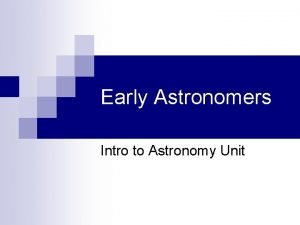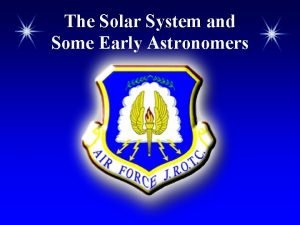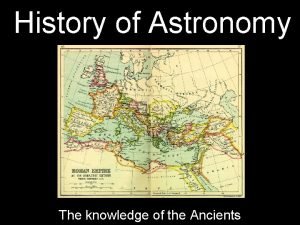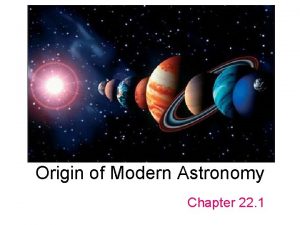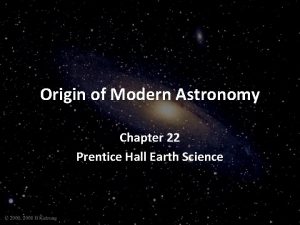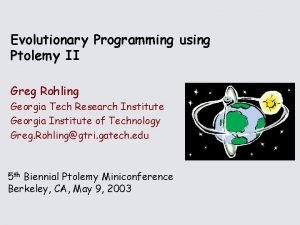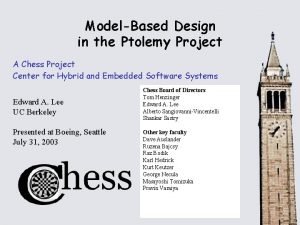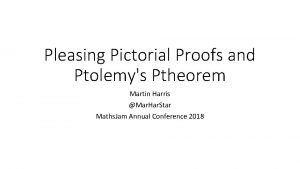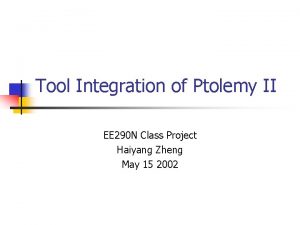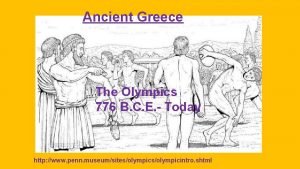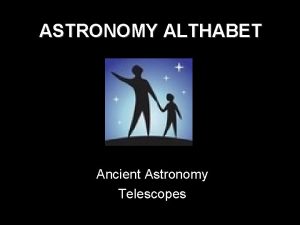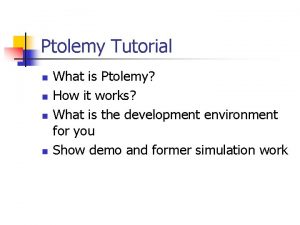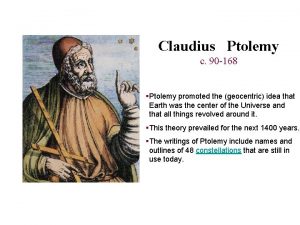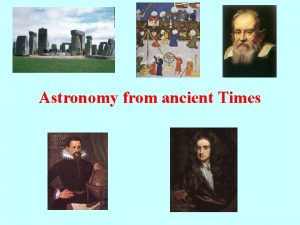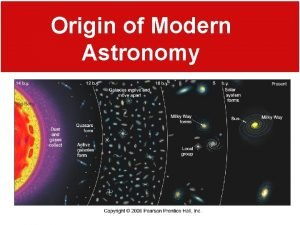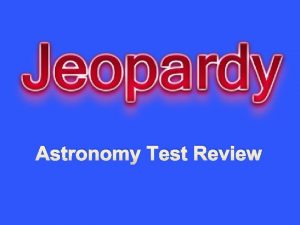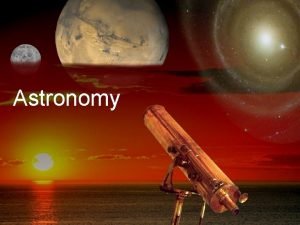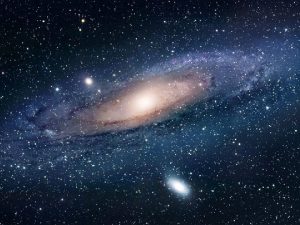Ancient to Modern Astronomy Ptolemy 85 A D

















- Slides: 17

Ancient to Modern Astronomy Ptolemy 85 A. D. to Newton 1727 View retrograde motion

Ptolemy (85 A. D. - 165 A. D. ) Ptolemy modified the geocentric model to account for the retrograde motion of planets Ø The "solution" to retrograde motion came in the form of a mad, but clever proposal Ø

Ptolemy (85 A. D. - 165 A. D. ) "Epicycles", and the concentric spheres to which they were attached were termed the "Deferents” Ø Centers of the epicycles executed uniform circular motion as they went around the deferent at uniform angular velocity, and at the same time the epicyles (to which the planets were attached) executed their own uniform circular motion Ø

Ptolemy (85 A. D. - 165 A. D. )

Claudius Ptolemaeus (Ptolemy) (85 A. D. - 165 A. D. ) l At first, not widely accepted because scientists thought the model to be too complicated l Although the geocentric model with epicycles did explain the motions of the planets better. l Important in terms of predicting astrology and fate.

Later refinements (2 nd century B. C. ) • Hipparchus: Placing the Earth away from the centers of the “perfect spheres” • Ptolemy: Further refinements, including epicycles

Epicycles Introduced to explain retrograde (westward) motion of planets The Ptolemaic system was considered the “standard model” of the Universe until the Copernican Revolution.

Epicycles View retrograde motion Video from Movies (SLIDESHOW MODE ONLY)

The Copernican Revolution Nicolaus Copernicus (1473 – 1543): Father of the Heliocentric Universe (Sun in the Center)

Nicolas Copernicus (1473 -1543) • Polish cleric first proposed the heliocentric model • Wrote the book De Revolutionibus and stashed it under his mattress • Proposed all planets including Earth revolve around the Sun • Circular orbits at constant velocities • Copernicus’ model was the best to date but still had problems accurately pinpointing the position of the planets

Copernicus’ new (and correct) explanation for retrograde motion of the planets Explanation of Retrograde Motion Retrograde (westward) motion of a planet occurs when the Earth passes the planet. This made Ptolemy’s epicycles unnecessary.

Explain the difference between the geo- and helio-centric models of the solar system. Earthcentered Suncentered

Galileo Galilei (1564 – 1642) • Invented the modern view of science: Transition from a faith-based “science” to an observation-based science. • Greatly improved on the newly invented telescope technology. (But Galileo did NOT invent the telescope!) • Was the first to meticulously report telescope observations of the sky to support the Copernican Model of the Universe.

Major Discoveries of Galileo (2) • Surface structures on the moon; first estimates of the height of mountains on the moon

Major Discoveries of Galileo • Moons of Jupiter (4 Galilean moons) (What he really saw) • Rings of Saturn (What he really saw)

Major Discoveries of Galileo (3) • Sun spots (proving that the sun is not perfect!)

Major Discoveries of Galileo (4) • Phases of Venus (including “full Venus”), proving that Venus orbits the sun, not the Earth!
 Claudius ptolemy astronomy contributions
Claudius ptolemy astronomy contributions Claudius ptolemy astronomy contributions
Claudius ptolemy astronomy contributions Learning astronomy by doing astronomy activity 1 answers
Learning astronomy by doing astronomy activity 1 answers Learning astronomy by doing astronomy
Learning astronomy by doing astronomy Learning astronomy by doing astronomy answers
Learning astronomy by doing astronomy answers Astronomy in ancient rome
Astronomy in ancient rome Origin of modern astronomy chapter 22
Origin of modern astronomy chapter 22 Johannes kepler
Johannes kepler Greg ptolemy
Greg ptolemy Abaforce
Abaforce Ptolemy theorem
Ptolemy theorem Ptolemy experiment
Ptolemy experiment Ptolemy tool
Ptolemy tool Daniel 8
Daniel 8 Ancient india vs ancient china
Ancient india vs ancient china Communication for primary 4
Communication for primary 4 üget
üget Romeo and juliet script translation
Romeo and juliet script translation
